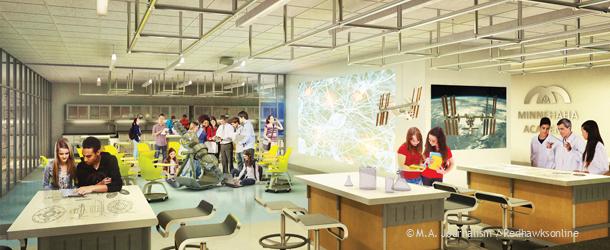Long-awaited renovations to the science department are planned to take place in 2015, improving labs for current classes in addition to opening up the possibility for new courses
Maybe you’ve heard the murmurs about building a lab just for ISS or the uproars about a tree coming down, but does anyone really know what’s going on?
Minnehaha will be building a new STEM (science, technology, engineering and math) research lab as well as renovating the already existing science classrooms. The new center will be used by many science courses for grades 9-12, as well as science based electives such as International Space Station (ISS), more recently known as Applied Research and Engineering.
“Updated facilities of the science department have been a priority of the leadership for quite some time,” said Executive Director of Institutional Advancement, Sara Jacobson.
“It did not get updated in the last building renovation when the fine arts wing and the gym got updated [in 2002]. With all the advancements in technology and the emphasis now on STEM to prepare students for college, this became a priority.”
Staying competitive with other schools was also a factor in making the expansion a priority. Being a private school market, Minnehaha needs to stay relevant. With the importance of STEM being pushed in the field of education, a renovation became needed.
“We don’t want to be left behind,” said president Donna Harris. “We know what our students need. I wouldn’t call it competition necessarily, our space will be what we need and what our science teachers envision, but certainly when prospective parents have places to choose when they’re thinking of other schools, our facilities and our experience for other students makes a difference for them.”
The ISS program was a contributor in the decision to do renovations. However, it was it was not a main factor.
“Looking down the road of what we want to be able to offer our students here and the types of opportunities we want to offer, we don’t want to limit ourselves because of our space,” said science teacher Sam Meyers. “We don’t want to have to say we can’t do ISS because we don’t have the infrastructure to do that.”
For example, Meyers went on to explain that the current space for ISS is not sufficient because of the lack of biological components when this years project is biologically based.
The project will be done in two phases. The first phase is the construction of the new lab and the renovations of the existing science classrooms. If funds are provided, the second phase (which may occur in the distant future) will be the building of an additional three floors of larger chemistry and biology labs and classrooms, possibly built toward the soccer field.
The new lab and classroom renovations are being designed by the Cunningham Group architecture firm with input from the science, math, and art department teachers, as well as technology staff. The renovation and expansion are mainly for space purposes for more classrooms and experiments.
The new STEM lab will be in the area between the Anderson Conference Room and the gym. It is planned on being a large space (about 3,000 square feet) that can be used for two different classrooms, most likely the main physics classroom and a space for the ISS program and other independent research projects.
The “dungeon area,” said Meyers, will become a meeting area or commons. The chemistry room will remain where it is and room B119 will become the main chemistry storage prep area. Room B118 will become a multi purpose room used as a workspace for small groups during classes and a discussion area for teachers and students.
The cottonwood tree located in the east courtyard nearest the building is scheduled to be removed. It is planned to be taken down as soon as possible after the ground has been thawed.
“I think it would be good to have new spaces and tools for the science department,” said sophomore Ben Dahlman. “I just feel bad that they’re chopping down the tree and ruining the link’s lighting, but maybe that’s just me.”
Individual donors, mostly alums and past or current parents, are providing funds for the project. A past parent gave the lead gift of $2 million. They have also supported the last two building campaigns at both campuses, but this is their biggest gift to the school yet. The name of the donor is yet to be recognized; however, they will be naming the new lab.
Currently, funds are available to break ground for the new lab, but not for the renovations of the existing classrooms. The expected time to break ground for the new lab is in April and will be most likely completed by September. About a million dollars is still needed to do construction on the existing classrooms.
Science teacher Carmella Whaley stated that because of the new facilities, it is possible that more types of engineering classes at different levels will be offered. New electives may be available, however all science course curriculum are planned to remain the same for the short term.
“In the future we would like to have a robotics team,” said science teacher Sam Terfa. “It would be nice to have an introductory course and we have a lot of the materials already. We are also considering adding a broader senior level project based course like a senior seminar where students work in pairs on a project all semester and even present in the regional science fair. We’ve been tossing around ideas but nothing is set in stone.”
The department also hopes to establish long-term internship opportunities with other companies where professionals can use the new space being built and students can get experience in the company’s workspace as well.
So who knows? Maybe by next school year, you’ll be walking into a brand new STEM lab.

